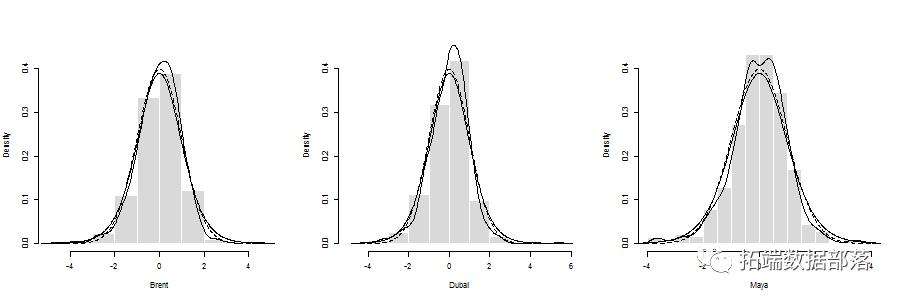R语言COPULA和金融时间序列案例
Posted 拓端数据部落
tags:
篇首语:本文由小常识网(cha138.com)小编为大家整理,主要介绍了R语言COPULA和金融时间序列案例相关的知识,希望对你有一定的参考价值。
原文 http://tecdat.cn/?p=3385
最近我被要求撰写关于金融时间序列的copulas的调查。从读取数据中获得各种模型的描述,包括一些图形和统计输出。
> temp < - tempfile()download.file(+“oil.xls",temp)> oil = read.xlsx(temp,sheetName =“DATA”,dec =“,”)oil = read.xlsx(“D:\ home \ acharpen \ mes documents \ oil.xls”,sheetName =“DATA”)
然后我们可以绘制这三个时间序列
1 1997-01-10 2.73672 2.25465 3.3673 1.54002 1997-01-17 -3.40326 -6.01433 -3.8249 -4.10763 1997-01-24 -4.09531 -1.43076 -6.6375 -4.61664 1997-01-31 -0.65789 0.34873 0.7326 -1.51225 1997-02-07 -3.14293 -1.97765 -0.7326 -1.87986 1997-02-14 -5.60321 -7.84534 -7.6372 -11.0549
这个想法是在这里使用一些多变量ARMA-GARCH过程。这里的启发式是第一部分用于模拟时间序列平均值的动态,第二部分用于模拟时间序列方差的动态。本文考虑了两种模型
关于ARMA模型残差的多变量GARCH过程(或方差矩阵动力学模型)
关于ARMA-GARCH过程残差的多变量模型(基于copula)
因此,这里将考虑不同的系列,作为不同模型的残差获得。我们还可以将这些残差标准化。来自ARMA模型
> fit1 = arima(x = dat [,1],order = c(2,0,1))fit2 = arima(x = dat [,2],order = c(1,0,1))fit3 = arima(x = dat [,3],order = c(1,0,1))m < - apply(dat_arma,2,mean)v < - apply(dat_arma,2,var)dat_arma_std < - t((t(dat_arma)-m)/ sqrt(v))
或者来自ARMA-GARCH模型
fit1 = garchFit(formula = ~arma(2,1)+ garch(1,1),data = dat [,1],cond.dist =“std”)fit2 = garchFit(formula = ~arma(1,1)+ garch(1,1),data = dat [,2],cond.dist =“std”)fit3 = garchFit(formula = ~arma(1,1)+ garch(1,1),data = dat [,3],cond.dist =“std”)m_res < - apply(dat_res,2,mean)v_res < - apply(dat_res,2,var)dat_res_std = cbind((dat_res [,1] -m_res [1])/ sqrt(v_res [1]),(dat_res [,2] -m_res [2])/ sqrt(v_res [2]),(dat_res [ ,3] -m_res [3])/ SQRT(v_res [3]))
多变量GARCH模型
可以考虑的第一个模型是协方差矩阵的多变量EWMA,
ewma = EWMAvol(dat_res_std,lambda = 0.96)
要想象波动性,请使用
> emwa_series_vol = function(i = 1){+ lines(Time,dat_arma [,i] + 40,col =“gray”)+ j = 1+ if(i == 2)j = 5+ if(i == 3)j = 9

隐含的相关性在这里
> emwa_series_cor = function(i = 1,j = 2){+ if((min(i,j)== 1)&(max(i,j)== 2)){+ a = 1; B = 9; AB = 3}+ r = ewma $ Sigma.t [,ab] / sqrt(ewma $ Sigma.t [,a] *+ ewma $ Sigma.t [,b])+ plot(Time,r,type =“l”,ylim = c(0,1))+}

也可能有一些多变量GARCH,即BEKK(1,1)模型,例如使用:
> bekk = BEKK11(dat_arma)> bekk_series_vol function(i = 1){+ plot(Time, $ Sigma.t [,1],type =“l”,+ ylab = (dat)[i],col =“white”,ylim = c(0,80))+ lines(Time,dat_arma [,i] + 40,col =“gray”)+ j = 1+ if(i == 2)j = 5+ if(i == 3)j = 9> bekk_series_cor = function(i = 1,j = 2){+ a = 1; B = 5; AB = 2}+ a = 1; B = 9; AB = 3}+ a = 5; B = 9; AB = 6}+ r = bk $ Sigma.t [,ab] / sqrt(bk $ Sigma.t [,a] *+ bk $ Sigma.t [,b])

从单变量GARCH模型中模拟残差
第一步可能是考虑残差的一些静态(联合)分布。单变量边际分布是

而关节密度的轮廓(使用双变量核估计器获得)

也可以将copula密度可视化(顶部有一些非参数估计,下面是参数copula)
> copula_NP = function(i = 1,j = 2){+ n = nrow(uv)+ s = 0.3+ norm.cop < - normalCopula(0.5)+ norm.cop < - normalCopula(fitCopula(norm.cop,uv)@estimate)+ dc = function(x,y)dCopula(cbind(x,y),norm.cop)+ ylab = names(dat)[j],zlab =“copule Gaussienne”,ticktype =“detailed”,zlim = zl)++ t.cop < - tCopula(0.5,df = 3)+ t.cop < - tCopula(t.fit [1],df = t.fit [2])+ ylab = names(dat)[j],zlab =“copule de Student”,ticktype =“detailed”,zlim = zl)+}

可以考虑这个 功能,
功能,

计算三对系列的经验版本,并将其与一些参数版本进行比较,
>> lambda = function(C){+ l = function(u)pcopula(C,cbind(u,u))/ u+ v = Vectorize(l)(u)+ return(c(v,rev(v)))+}>> graph_lambda = function(i,j){+ X = dat_res+ U = rank(X [,i])/(nrow(X)+1)+ V = rank(X [,j])/(nrow(X)+1)+ normal.cop < - normalCopula(.5,dim = 2)+ t.cop < - tCopula(.5,dim = 2,df = 3)+ fit1 = fitCopula(normal.cop,cbind(U,V),method =“ml”)d(U,V),method =“ml”)+ C1 = normalCopula(fit1 @ copula @ parameters,dim = 2)+ C2 = tCopula(fit2 @ copula @ parameters [1],dim = 2,df = trunc(fit2 @ copula @ parameters [2]))+

但人们可能想知道相关性是否随时间稳定。E:
> time_varying_correl_2 = function(i = 1,j = 2,+ nom_arg =“Pearson”){+ uv = dat_arma [,c(i,j)]nom_arg))[1,2]+}> time_varying_correl_2(1,2)> time_varying_correl_2(1,2,“spearman”)> time_varying_correl_2(1,2,“kendall”)

斯皮尔曼与时间排名相关

或肯德尔

为了模型的相关性,考虑DCC模型(S)
> m2 = dccFit(dat_res_std)m3 = dccFit(dat_res_std,type =“Engle”)R2 = m2 $ rho.tR3 = m3 $ rho.t

要获得一些预测, 使用例如
> garch11.spec = ugarchspec(mean.model = list(armaOrder = c(2,1)),variance.model = list(garchOrder = c(1,1),model =“GARCH”))dcc.garch11.spec = dccspec(uspec = multispec(replicate(3,garch11.spec)),dccOrder = c(1,1),distribution =“mvnorm”)dcc.fit = dccfit(dcc.garch11.spec,data = dat)fcst = dccforecast(dcc.fit,n.ahead = 200)

点击标题查阅往期内容
更多内容,请点击左下角“阅读原文”查看


![]()
案例精选、技术干货 第一时间与您分享
长按二维码加关注
更多内容,请点击左下角“阅读原文”查看
以上是关于R语言COPULA和金融时间序列案例的主要内容,如果未能解决你的问题,请参考以下文章